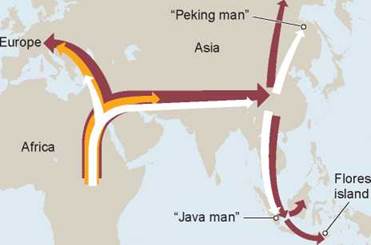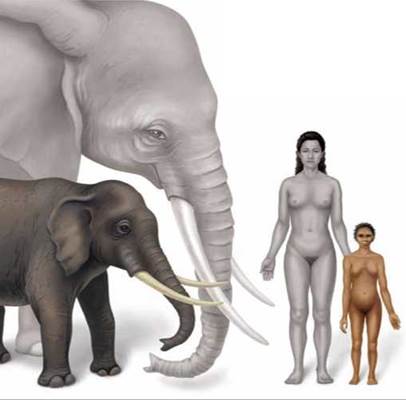THE LIVING WORLD
Unit Five. Evolution of Animal Life
21. How Humans Evolved
21.7. Our Own Species Also Evolved in Africa
The evolutionary journey to modern humans entered its final phase when modern humans first appeared in Africa about 600,000 years ago. Investigators who focus on human diversity consider there to have been three species of modern humans: Homo heidelbergensis, H. neanderthalensis, and H. sapiens.
The oldest modern human, H. heidelbergensis, is known from a 600,000-year-old fossil from Ethiopia. Although it coexisted with H. erectus in Africa, H. heidelbergensis has more advanced anatomical features, such as a bony keel running along the midline of the skull, a thick ridge over the eye sockets, and a large brain. Also, its forehead and nasal bones are very like those of H. sapiens. H. heidelbergensis seems to have spread to several areas in Africa, Europe, and western Asia.
As H. erectus was becoming rarer, about 130,000 years ago, a new species of human, H. neanderthalensis, appeared in Europe. H. neanderthalensis likely branched off from the ancestral line leading to modern humans 500,000 years ago. Compared to modern humans, Neanderthals were short, stocky, and powerfully built. Their skulls were massive, with protruding faces, heavy, bony ridges over the brows, and larger braincases.
Out of Africa—Again?
The oldest fossil known of Homo sapiens, our own species, is from Ethiopia and is about 130,000 years old. Outside of Africa and the Middle East, there are no clearly dated H. sapiens fossils older than roughly 40,000 years of age. The implication is that H. sapiens evolved in Africa and then migrated to Europe and Asia: a hypothesis called the Recently-Out-of-Africa Model. An opposing view, the Multiregional Hypothesis, argues that the human races independently evolved from H. erectus in different parts of the world.
Recently, scientists studying human DNA have helped clarify this controversy. Researchers sequencing mitochondrial DNA and a variety of nuclear genes on the Y and X chromosomes and on autosomes have consistently found that all H. sapiens shared a common ancestor 170,000 years ago. Scientists now generally accept the conclusions of this broad array of gene data: The Multiregional Hypothesis is wrong. Our family tree has a single stem.
The DNA data reveal a distinct branch on the H. sapiens family tree 52,000 years ago, separating Africans from nonAfricans. This is consistent with the hypothesis that H. sapiens originated in Africa, from there spreading to all parts of the world, retracing the path taken by H. erectus half a million years before. Figure 21.9 traces the proposed paths taken by three different species of Homo. H. erectus, shown by the white arrows, evolved first and left Africa, spreading out across Europe and Asia. H. heidelbergensis evolved later and followed a similar path, indicated by the orange arrows. Still later, H. sapiens repeated the pattern, indicated by the red arrows, but traveled even farther.

Figure 21.9 Out of Africa—many times.
Several lines of evidence indicate that Homo spread from Africa to Europe and Asia repeatedly. First, H. erectus (white arrow) spread as far as Java and China. Later, H. heidelbergensis (orange arrow) migrated out of Africa and into Europe and western Asia. And the pattern is repeated again still later by H. sapiens (red arrow) who migrated out of Africa and into Europe and Asia and eventually into Australia and North America. Lowering of sea levels due to Ice Age coolings made it possible to migrate between landmasses that are currently separated by water. Fossils of H. neanderthalensis are known only from Europe and Mediterranean regions, implying that this species may have evolved in Europe.
A Fourth Species of Recent Human
Evidence has begun to accumulate suggesting that until as recently as 13,000 years ago another species of human existed, hidden away from us on a tiny island in Indonesia. Only 1 meter tall, Homo floresiensis has been a startling discovery, one that is still being verified, as described on the facing page.
A Fifth?
Even more recently, in 2010, evidence has emerged pointing to the possible existence of yet a fifth species of recent human, one that coexisted with Neanderthals and H. sapiens in Asia 40,000 years ago. The tantalizing evidence comes from DNA extracted from a human finger bone preserved in a cold mountain cave in southern Siberia. The cave is rich in stone tools, but reveals only scattered human bones. When researchers sequenced mitochondrial DNA, they found a human sequence, but one unlike either Neanderthals or H. sapiens. The data hint at an unknown type of human that left Africa in a previously unsuspected migration about 1 million years ago.
Key Learning Outcome 21.7. Homo sapiens, our species, seems to have evolved in Africa and then, like H. erectus and H. heidelbergensis before it, migrated to Europe and Asia.
Today’s Biology
Meet Our Hobbit Cousin
For the last several years, the field of paleoanthropology, the study of human evolution, has been stood on its head by a tiny fossil from Indonesia.
This story begins in 1996, when Australian paleoanthropologist Michael Morwood reported that his team had excavated stone tools from a site on Flores island 300 miles south of Borneo in Indonesia. The site was almost a million years old, long before the period when scientists thought sophisticated humans arrived there. Even more to the point, Flores is isolated by a deep-water trench from the rest of Asia. This deep-water barrier is called the Wallace Line after Darwin's contemporary Alfred Russel Wallace who first noticed the marked differences between animals living on either side of it. On one side they resemble Asian species but on the other side they resemble Australian species. Might early humans have somehow managed to cross?
Morwood and Indonesian collaborators started looking for fossils on both sides of the Wallace Line. In 2001 they began to examine caves that had been explored years earlier by other archaeologists, and in 2003 they hit paydirt at Liang Bua ("cool cave”). Six meters under the floor of the cave, in 18,000-year-old sediment, Morwood's team found the nearly complete fossil skeleton of a hominid, an early human. The teeth are worn, and the skull bones are knitted together in an adult way, so the fossilized individual was an adult—but an adult hominid only 1 meter tall, with a brain of only 380 cc (cubic centimeters)! This is the stature and brain size of a chimpanzee. The fossil foot, essentially complete, is extremely large. Workers at the site nicknamed the newly discovered hominid "the hobbit” after the J.R.R. Tolkien characters in the book The Lord of the Rings.
A firestorm of controversy broke out among the scientific community. This Homo floresiensis, as Morwood dubbed the fossil, makes no sense when viewed against the detailed picture paleoanthropologists have pieced together of human evolution. For one thing, it is too young. In a 3-million-year-old prehuman ancestor, the Flores fossil's tiny dimensions would not be surprising, but the fossil is only 18,000 years old. That means it was alive when Homo sapiens (modern human) had evolved and even crossed the Wallace Line to Australia.
For another thing, the Flores individual is too short. Early African human ancestors called australopithecines were this size, 20 kg and about a meter tall, but every adult human fossil ever found is much bigger and taller. The humans alive 18,000 years ago were not tiny but the same stature as humans today.
And yet, despite all these objections that the Flores fossil could not exist, there it is, hard data. What are we to make of it? Morwood's suggestion is that the Flores fossil is a member of a human species that evolved in isolation on Flores island from ancient humans that reached there long ago. The ancestor of Homo sapiens, called Homo erectus, shares certain characteristics with the Flores fossil and so is the most likely candidate. Morwood goes on to point out that large mammals colonizing remote small islands often tend to evolve into isolated dwarf species. Many examples are known, including pygmy hippos, ground sloths, deer, and even dinosaurs. Indeed, pygmy elephants no bigger than cattle lived on Flores island at that very time; fossils of hunted specimens are found in the Liang Bua cave! Why do dwarf species evolve? The theory is that on islands with few or no predators, there is no advantage to being big, and with limited food there is great advantage to being small. On Flores island, Morwood suggests, the human evolutionary story has played out differently than it did in Africa, evolution favoring the small.
"Wait a minute,” cry researchers from the Field Museum in Chicago, who in 2006 challenged the classification of the Flores fossil as a new species. Its brain is simply too small for a dwarf species, they claim—judging from other instances in which pygmy species have developed in isolation, the Flores brain size of 380 cc would indicate a creature only 1 foot tall! They propose that instead it may be a modern human suffering from microencephaly, a genetic disorder that results in small brain size.
Morwood's team is not ready to concede the argument. In subsequent digs at the Liang Bua cave in 2004 they have found a total of eight more tiny individuals, all of them even smaller than the complete fossil unearthed the previous year. It stretches the imagination to believe that all suffer from microencephaly. Strengthening their claim that the Flores fossils are not modern humans was the discovery of two complete lower jaws, neither of which have chins. Chins are found on the lower jaws of all modern human fossils.
The Floresians of the Liang Bua region seem to have perished after an eruption of one of the island's many volcanoes about 13,000 years ago. But they may have survived much longer elsewhere on Flores, Dr. Morwood believes. The search for more fossils goes on.

Homo floresiensis (far right) compared with a modern human female. H. floresiensis preyed upon a dwarf species of elephant, which also occurred on the island of Flores.